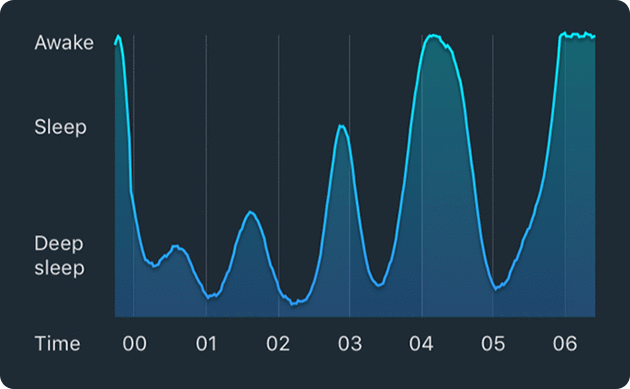The Sleep Stages: What You Need To Know
Sleep is not as relaxing for your mind and body as you might think. While you sleep, your body and brain processes new information, regulates hormones, heals sore muscles and illness and replenishes your energy. All of these things happen while you sleep in a specific cycle of Sleep Stages. Here is everything you need to know about the sleep stages.
How many Stages of Sleep Are There?
There are four stages of sleep. One for rapid eye movement - REM - sleep, two types of non-REM sleep - light and deep sleep - and then a stage for wakefulness. Since this is a cycle and repeats, some refer to the “repeat” of the cycle as a fifth stage.
Stage 1: Wakefulness of Dozing
This first stage of sleep usually lasts about 1-5 minutes. It’s the stage where your mind and body are more aware and “awake” but you definitely aren’t alert.
Why Stage 1 Matters
This sleep stage is when chemical changes in your mind and body begin to help you fall asleep. It is the signal to your body that some zzz’s are coming. It would still be quite easy to wake up a person in this stage but, if they aren’t disturbed, they will move on to Stage 2.
While Stage 1 is common for all people when they first fall asleep, it may not be experienced again later on in the night as the person falls further and further into the sleep cycle.
Stage 2: Light Sleep
Light sleep is the sleep people enter once they first actually fall asleep. Heart and breathing rates drop much lower than average daily rates and a person's brain will fire messages and electrical signals at this stage.
Light sleep takes up more than half of the night for the average adult. It is not as deeply refreshing for the body as deep sleep, but it is just as important.
Why Stage 2 Matters
Stage two of sleep matters because this is when learning, memory processing and new experiences are stored and communicated to the brain. The electrical activity happening at this sleep cycle is the brain communicating and sending signals while your body rests. Your metabolism regulates and emotions can be processed at this stage too. When people say “sleep on it”, it is light sleep that is responsible for the clarity that a person can feel the next morning.
Stage 3: Deep Sleep
Your brain is most relaxed during Stage 3 of the sleep cycle. Deep sleep is when your heart rate and breathing drop to their slowest rate. Your muscles relax and your body is even further away from consciousness. Even loud noises cannot usually wake a person during deep sleep.
If you are awoken during this sleep cycle, you will often feel groggy and sleepy for at least a few hours after waking up, if not for the entire day. Much like Stage 1, this sleep stage can get shorter and shorter throughout the night.
Why Stage 3 Matters
Deep sleep is important because it is when healing and regeneration takes place in your body. Blood supply to the muscles and organs are increased. Growth, development and overall health are greatly impacted by deep sleep - in very positive ways! This is often why children and infants going through growth spurts can seem sleepier or can sleep for longer periods of time.
Stage 4: REM Sleep
REM sleep is probably the most talked about sleep cycle. Since REM is where dreams occur, it is the most popular cycle and often looked at as the most important. REM stands for rapid eye movement. It is called this because your eyes literally dart about during this sleep cycle. If you were to watch someone while they slept, you would see their eyes moving under their eyelids while they were in REM sleep.
Why do Eyes Move During REM?
Eye movement during REM sleep is linked to the specific type of brain activity that happens during this sleep cycle. In fact, a study found that the bursts of brain activity which happen during each eye movement are similar to when we see a new image or picture while awake. This has led scientists to believe that the eye movement during REM sleep is literally our brains “flickering” or “moving” between scenes of our dreams.
Why Stage 4 Matters
REM sleep matters because it is when we dream. The stimulation that occurs during this time is linked to learning and retaining memories, much like Stage 2. Dreams are one of the biggest mysteries of sleep to this day and we still don’t really know why we dream. REM makes up about 25% of sleep each night.
The Typical Sleep Cycle
A typical sleep cycle can change slightly the longer you’re asleep. The first sleep cycle is often the shortest and usually lasts between 70 - 100 minutes. As the night goes on, sleep cycles can last up to two hours. The amount of time a person spends in each stage can also change throughout the night. Stage 3 - Deep Sleep - can get shorter while REM sleep can get longer. Wakefulness can be eliminated altogether.
After a sleeper goes through each of the stages, the stages repeat themselves and the cycle starts all over again. Some sleep doctors refer to ‘repeat” as the fifth stage of sleep. The typical adult will go through four or five sleep cycles a night and will most commonly wake up at the end of a sleep cycle when REM sleep is finishing up.
The Sleep Stages and Sleep
Many people like to think that Stage 4 - REM sleep - is the most important stage in the sleep cycle. This couldn’t be further than the truth. Each stage has its own benefits for both your mind and body and plays a vital role in health as a whole.

